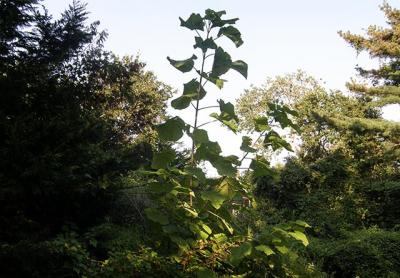Nature Notes: Ready for Yesteryear

In the 1940s almost every family on the North Fork had at least one dog and one cat. Many families kept a larger menagerie — pigs, chickens, goats, cows, and sometimes a horse or two. Horses were an extravagance; you couldn’t eat them nor did they give milk or lay eggs, and they were no longer needed to pull plows and other farm implements, having been replaced in the 1920s and 1930s by tractors.
Garbage trucks didn’t come around and pick up the trash; each family used a “community dump,” a pile of debris in the woods that never seemed to get any larger. We didn’t throw much away in those days, perhaps because there was no plastic packaging then. Garbage from meals, or the “slops,” went to the pigs and chickens. The food chains in those days went both down and up.
Weeds were a problem, but we took care of them in short order. We hoed the ones between the rows of vegetables and pulled the others, again, feeding them to the chickens and pigs. When the chickens free-ranged, they eliminated us middlemen, gathering and eating the weeds themselves.
There was no mugwort, Japanese knotweed, garlic mustard, giant hogweed, and mile-a-minute vine to contend with, just lamb’s quarters, ragweed, and dandelions. Lamb’s quarters were highly prized by our barred rock chickens. They would eat ragweed if there was nothing else to chew on, but dandelions were too small to mess with. However, lots of locals made salads of dandelion greens, sometimes throwing in young lamb’s-quarters, which tasted a little like kale or chard.
We all gathered berries — blueberries, wild cherries, wild raspberries, huckleberries, and beach plums — when they were ripe. There were no cranberries to speak of on the North Fork, so some of us made annual forays to South Fork cranberry bogs come early fall. Of course, in addition to the wild stuff, we all had vegetable gardens and domestic fruit trees. And, of course, there were ample supplies of fresh clams, mussels, oysters, scallops, and fish of all kinds. Food was never a problem. We were poor but we ate better than most rich people.
We could do a lot of things with “raw” milk that was fresh out of the udder and neither pasteurized nor homogenized. We would separate the cream from the milk; it was lighter and rose to the top of the container for easy removal. We could take that milk and cream to make yogurt, pot cheese, sour cream, and on very hot summer days, we would get out the churn and make ice cream. Put ice in the bucket, cream with fruit in the churn, and turn and turn and turn and turn, churn and churn and churn. Eventually you had ice cream so thick that you could barely turn the churn. It was so good it was all gone in less than half an hour.
There were no helicopters buzzing overhead and as many bicycles plying the local roads as motor vehicles. Fireflies lighted the evening skies, tree crickets sang to us from the trees and bushes. Strutting roosters crowed at 6 in the morning to wake us up, not the big trucks and motorcycles streaming by on Noyac Road that shake me awake each morning nowadays. Whippoorwills started trilling at twilight and ushered us young’uns into dreamland without a cry or a whimper.
Hard work and simple pleasures got us through each day enthusiastically and with a smile. What a life. If any of you know where I can find a similar niche and habitat to retire to, please let me know! I’m ready and able, one might even say champing at the bit!
Larry Penny can be reached via email at [email protected].
